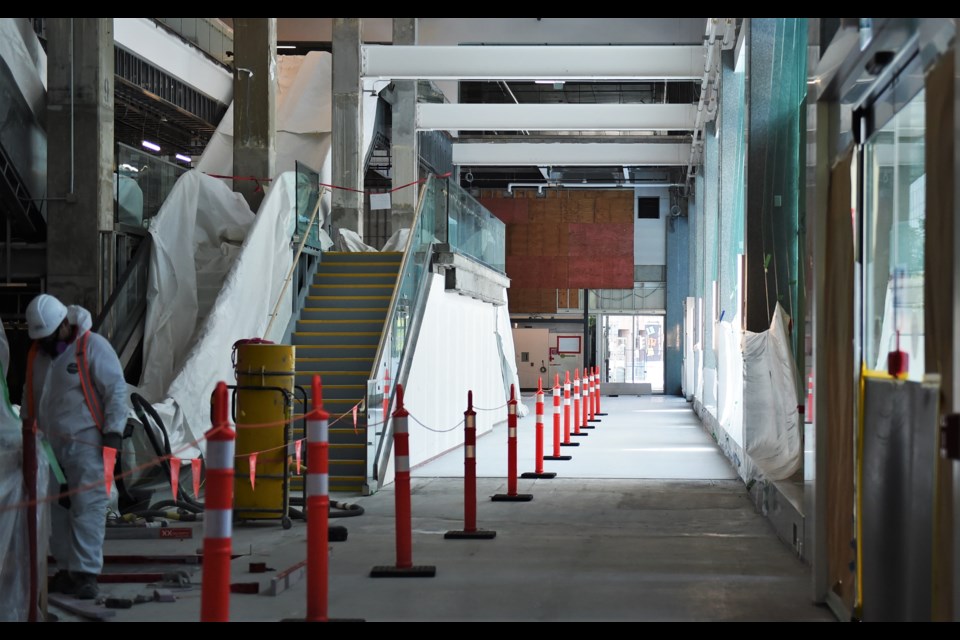The Post in Downtown Vancouver is getting close to delivery.
The former Canada Post facility is being redeveloped into a 1.1 million square foot Amazon office space with a full spectrum of food options for the public downstairs (from a huge grocery store to a Brazillian steakhouse, with lots in between).
A huge Amazon office
It's nearing completion says Amazon spokesperson Kristin Gable.
"Amazon teams will start moving into the south tower this fall," she says.
The south tower will be the first area completed; the north tower has been built, but what the space will be used for is still being determined.
Inside the south tower Amazon Web Services, retail technology teams, and other parts of Amazon's tech teams will work in an agile workspace Gable says. "Through the agile workspace teams will have an assigned neighbourhood, meaning an area where they're going to be working together," she clarifies. "That will generally mean an open space work environment where teams will have a dedicated place to go."
In addition to the main work area, there are private spaces for quiet moments or phone calls (some rooms are even called 'phone booths'), along with larger workspaces where teams can meet and interact as a group. Flexibility is a central idea, she says.
Among the perks is the fact the office will be dog-friendly, and designed so. That means things like rooftop dog parks (complete with fire hydrants).
Also on the rooftop is a huge basketball (or volleyball) court that can be used for team barbeques. It's actually built on a structure that sits on top of the post office's original roof. Below that is something dubbed a mega floor, which is a huge space of around 90,000 feet with very high ceilings.
Food for the people
While Amazon will be the major tenant with thousands of workers, the bottom floors will be a public area, with a variety of food options from grocery stores to seated dining.
So far Loblaws has committed to a 47,000-square-foot purpose-built store as part of its CityMarket brand. There'll also be a Fogo de Chao Brazillian steakhouse, a Deville coffee shop, and açai smoothie shop Oakberry. B.C.-based Joseph Richard Group is taking on two locations inside the street-level floor.
There's also a food hall planned which will operate like a 'food street' and have a liquor license. It's where the Vancouver Museum's historic neon lights collection will be displayed, with more than a dozen pieces from Vancouver's vibrant past.
All this will be accessible from inside, where a large indoor public space will run alongside Homer Street from Dunsmuir to West Georgia, following the theme of connectivity.
Keeping the good stuff
From the outside, it'll have a familiar facade, with much of the Post retaining the exterior pieces of the old postal facility. But it goes deeper says QuadReal vice president Graeme Scott.
"There's the keeping of the architecture and the heritage, and there's keeping the structure and saving carbon. And so we did both," he says.
That means using the original steel beams and some of the concrete slabs that made up the original structure.
"We've renewed it," he says of the portions they've kept. "We've replaced the glass, we've improved the tile, we've cleaned it, we've given it another 50-plus years of life."
It's also a more sustainable practice he adds, as new concrete and steel isn't required.
"We see this building, and it is no question, one of the most ambitious, historic rehab redevelopment sites in Canada," Scott says.
The interior design is "sympathetic to the 50s" he adds, since that's when the original structure was built.
"The design, the interior design, as you can see from the renderings, the flooring and the furnishings we've chosen, even the lamps are all intended to reflect on the positive side of what the 50s had to offer," he shares.
That also means some of the art that was part of the original structure is returning, like Paul Huba's untitled tile piece of a woman and child (which has been undergoing a multi-year restoration and is currently being installed). Huba's Postman and Orville Fisher's untitled mural are also returning.
Scott says there's no other project like this in the city, or really, the broader region mixing historic buildings, renewed, with public space and a broad food selection. "You see something more like this in New York," he says. "You might see it in San Francisco in one of the older downtown cores where they rejuvenated the space."



